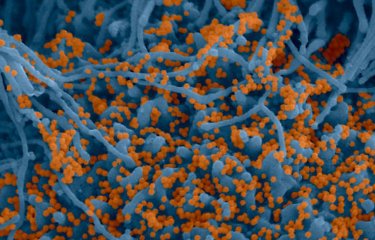-
Document de presse | 2021.03.07
COVID-19: neutralizing immune response lasts longer in women than in men
As part of the SEROCoV-HUS study, teams from Strasbourg University Hospital and the Institut Pasteur monitored 308 hospital staff who had previously contracted a mild form of SARS-CoV-2. The scientists demonstrated that neutralizing antibodies could be detected in 84% of them up to 6 months after infection, but that the level fell more quickly in men than in women. These results seem to suggest...
-
Document de presse | 2020.09.10
Editorial: How can we reach a level of herd immunity that will protect us from COVID-19?
Epidemiological theory teaches us that a microbial agent introduced into a population stops circulating when the proportion of the population that is immune to that agent is higher than or equal to 1-1/R0, where R0 is the much-discussed reproduction rate, the number of secondary cases generated by each infected person in a non-immune population in the absence of control measures. In France, where...
-
News | 2020.04.14
COVID-19, chronicle of an expected pandemic / Exiting lockdown or the sum total of all dangers
Professor Philippe Sansonetti explains that a lockdown was needed because social distancing measures were not enough on their own. He goes on to outline the conditions that will be required for a future exit strategy – but makes it clear that this strategy will not signal the end of distancing measures. This article was written by Philippe Sansonetti and published on the website "La Vie des...
-
Document de presse | 2020.05.26
COVID-19: the vast majority of patients with a minor form develop neutralizing antibodies
Teams from Strasbourg University Hospital and the Institut Pasteur carried out a study among hospital staff on the two sites of Strasbourg University Hospital. After observing 160 people with minor forms of COVID-19, the scientists concluded that nearly all the patients developed antibodies within two weeks of being infected. In 98% of the patients, neutralizing antibodies were detected after 28...
-
News | 2020.06.05
Covid-19: a study in children with hyper-inflammatory syndrome related to Kawasaki disease
The team of the Department of General Pediatrics and Infectious Diseases of the Necker-Enfants Malades AP-HP Hospital, the Institut Pasteur, Inserm and the University of Paris, conducted a prospective observational study between April 27 and May 15, 2020 to describe the characteristics of children and adolescents hospitalized in a context of Kawasaki disease-like syndrome in a COVID-19 epidemic...
-
Document de presse | 2020.06.23
COVID-19 in primary schools: no significant transmission among children or from students to teachers
In late April 2020, scientists at the Institut Pasteur, with the support of the Hauts-de-France Regional Health Agency and the Amiens Education Authority, carried out an epidemiological survey on 1,340 people linked to primary schools in Crépy-en-Valois, in the Oise department. Thanks to the cooperation of the people of Crépy-en-Valois, the survey, which made use of serological tests developed by...
-
Document de presse | 2021.12.23
COVID-19 – Omicron: resistant to most monoclonal antibodies but neutralized by a booster dose
The Omicron variant was detected for the first time in South Africa in November 2021 and has since spread to many countries. It is expected to become the dominant variant within a few weeks or months. Initial epidemiological studies show that the Omicron variant is more transmissible than the currently dominant virus (the Delta variant). It is capable of spreading to individuals who have received...
-
News | 2020.05.14
LuLISA project, bioluminescence as a tool for human diagnostics, from allergy to Covid19
The LuLISA (Luciferase-Linked ImmunoSorbent Assay) research project aims developing high throughput serological tests for epidemiological studies at local, regional or nation scales. In a recent scientific publication, concerning the detection and dosing of IgE specific to several allergens in patients’ blood samples, the use of LuLISA proves to be a vastly improved detection method in...
-
Article | 2020.10.14
Covid-19: vaccine against SARS-CoV-2 infection, using the measles vector
Phase I testing in humans for the Institut Pasteur's SARS-CoV-2 vaccine candidate using the measles vector was lauchned in August 2020 in France and Belgium. Following the intermediate results of the Phase I clinical trial, the Institut Pasteur is stopping (January, 2021) development of the vaccine candidate based on the measles platform.
-
Document de presse | 2023.12.05
COVID-19: the persistence of SARS-CoV-2 in the lungs and the role of innate immunity
One to two weeks after contracting COVID, the SARS-CoV-2 virus generally becomes undetectable in the upper respiratory tract. But does that mean that it is no longer present in the body? To find out, a team from the Institut Pasteur specialized in HIV, in collaboration with a French public research institute, the Alternative Energies and Atomic Energy Commission (CEA), conducted a study on lung...

